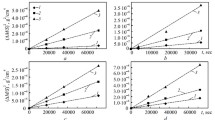We analyze the corrosion resistance of VT1-0 titanium and VT6 titanium alloy (Ti–6Al–4V) with residual porosities of 1, 3, and 4% obtained as a result of cold pressing and vacuum sintering of titaniumhydride powders in 10, 20, and 30% aqueous solutions of hydrochloric acid. The obtained results are compared with the data on corrosion resistance of the materials produced according to the traditional technology. It is established that titanium and its alloy obtained by the method of powder metallurgy dissolve in concentrated solutions of hydrochloric acid faster than the materials prepared according to the standard technology. The intensity of corrosion dissolution increases with the growth of the residual porosity of sintered materials and the concentration of hydrochloric acid. The corrosion characteristics of titanium and its alloy with residual porosities of 1 and 3%, independently of the technology of production, do not exhibit any noticeable difference, despite the fact that the corrosion resistance of the alloy somewhat increases. The corrosion resistance of sintered VT6 alloy (Ti–6Al–4V) with a residual porosity of 4% is twice higher than for titanium.




Similar content being viewed by others
References
F. H. Froes, S. J. Mashl, V. S. Moxson, J. C. Hebeisen, and V. A. Duz, “The technologies of titanium powder metallurgy,” J. Miner., Met. Mater. Soc., 56, No. 11, 46–48 (2004).
Z. Z. Fang, J. D. Paramore, P. Sun, and K. S. Ravi Chandran, “Powder metallurgy of titanium—past, present, and future,” Int. Mater. Rev., 63, No. 7, 407–459 (2018).
F. H. Froes and D. Eylon, “Powder metallurgy of titanium alloys,” Int. Mater. Rev., 35, No. 3, 162–182 (1990).
I. M. Pohrelyuk, O. V. Ovchynnykov, A. A. Skrebtsov, and Kh. S. Shvachko, “Effect of the starting powder mixture on the porosity and corrosion properties of sintered titanium in corrosive media,” Powder Metall. Met. Ceram., 55, No. 7, 445–453 (2016).
I. M. Pohrelyuk, O. V. Ovchynnykov, A. A. Skrebtsov, B. P. Bakhmatyuk, and Kh. S. Shvachko, “Electrochemical behavior of titanium synthesized by the method of powder metallurgy in hydrochloric acid,” Fiz.-Khim. Mekh. Mater., 52, No. 2, 92–97 (2016); English translation: Mater. Sci., 52, No. 2, 246–252 (2016).
І. М. Pohrelyuk, O. V. Ovchynnykov, А. А. Skrebtsov, Kh. S. Shvachko, R. V. Proskurnyak, and S. М. Lavrys,’ “Corrosion properties of titanium obtained by the method of powder metallurgy,” Fiz.-Khim. Mekh. Mater., 52, No. 5, 88–92 (2016); English translation: Mater. Sci., 52, No. 5, 700–705 (2017).
S. Candan, M. Turkmen, H. Ahlatci, and E. Candan, “Corrosion resistance of powder injection moulded titanium in physiologic serum and artificial saliva,” Acta Metall. Sin. (Engl. Lett.), 23, No. 3, 197–205 (2010).
Author information
Authors and Affiliations
Corresponding author
Additional information
Translated from Fizyko-Khimichna Mekhanika Materialiv, Vol. 56, No. 5, pp. 33–39, September–October, 2020.
Rights and permissions
About this article
Cite this article
Pohrelyuk, І.М., Savvakin, D.H., Melnyk, K.R. et al. Corrosion Resistances of VT1-0 Titanium and VT6 Titanium Alloy Obtained by the Method of Powder Metallurgy in Aqueous Solutions of Hydrochloric Acid. Mater Sci 56, 613–621 (2021). https://doi.org/10.1007/s11003-021-00472-y
Received:
Published:
Issue Date:
DOI: https://doi.org/10.1007/s11003-021-00472-y




